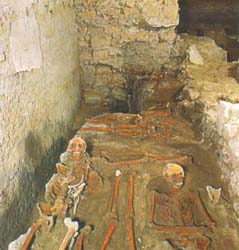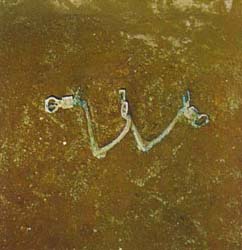
- Fig.1 - an overall view of a part of the necropolis
THE NECROPOLIS
From the middle of V century and the beginning of VI century A.C. the tank of late imperial age (G), now abandoned, is filled by earth, ruins of ancient buildings, fragments of white marmorean coating, polychrome ones and a lot of pottery. The materials gathered in this accumulated layers represent well the objects used in Neapolis in that period, both of local production and of importation from Africa (cups, plates, amphoras and oil lamps) and from East (plates and amphoras).
Successively, between VI and XIII century, age of the Angevin building construction, a necropolis is estabilished in the area.
About 50 tombs are, infact, identified and excavated; they are disposed on several levels and are partly damaged by the superposition of other tombs first, then, by the construction of successive structures.
